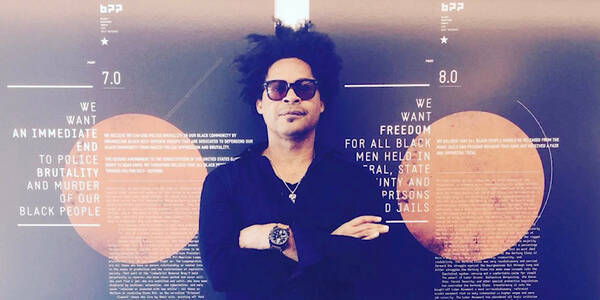
feature / faculty / graphic-design
March 07, 2018
Writer: Solvej Schou
Images: Courtesy of
Gloria Kondrup, Tyrone Drake, Simon Johnston
TYPOGRAPHY AND DESIGN’S POWER TO FUEL ‘PROTEST, PERSUASION, EMPOWERMENT’
“Your body is a battleground.”
So declares Barbara Kruger’s huge and pivotal reproductive rights silkscreen Untitled (Your body is a battleground) in stark white Futura Bold Italic type over red panels, layered on top of a black-and-white photo of a woman’s face. Created in 1989, the feminist piece and its commanding words continue to resonate today.
From anti-Vietnam pamphlets and posters in the ’60s to hand-drawn paint-splashed posters at current-day protests in support of women, immigrants, people of color, LGBTQ communities and the environment, to social media-driven viral memes, the intersection between typography, design, social movements, news and politics is constantly shifting, and ripe for discussion.
At ArtCenter, those discussions have been led in part by the College’s Hoffmitz Milken Center for Typography (HMCT), which opened in 2015. This Saturday, HMCT leans in to the topic with its day-long symposium Vox Pop LA, themed “Typographic Voices: Protest, Persuasion, Empowerment.” The symposium, and the upcoming dialog series Vox Pop London, will examine how typography and design affect our world and influence our opinions. Feminae, an HMCT exhibition of typographic voices of women, by women, with works by Kruger, the Guerilla Girls and more—curated from the Los Angeles-based Center for the Study of Political Graphics’ extensive poster collection—opens the evening of Vox Pop LA.


Typography and language influence and effect change, and that's also what ArtCenter is about: influencing and effecting change.
Gloria Kondrup
“Typography has long had historical importance, from typographic and visual campaigns for World War I to electing our first African-American president,” says Professor Gloria Kondrup (MFA 93 Graphic Design), executive director of HMCT and director of ArtCenter’s letterpress studio Archetype Press. “Typography and language influence and effect change, and that’s also what ArtCenter is about: influencing and effecting change,” adds Kondrup.
Raised in New York City, the longtime design educator, design consultant and fine artist shifted in her career from corporate design and branding to sustainability design, and won the AIGA Greening of Design award in 1997.
“I look at language as a sustainable cultural artifact,” says Kondrup. “The language and words we use are significant to how we define ourselves, and can really impact how an issue is conveyed. Typographic form gives voice to meaning.” For the Fall 2017 Archetype Press project Pressing Issues, students created a broadside—a proclamation printed on one side of a piece of paper—about an issue that mattered to them, from immigration to gender inequality and LGBTQ rights.
Graphic Design Associate Professor Tyrone Drake (BFA 96), a moderator and speaker at Vox Pop, views the intersection between typography, design and social justice as personal. As a kid in Oakland in the ’60s, he participated in the Black Panthers’ free breakfast program.


In his poster series Hard Bop: Reflections and Interpretations of a Militant Manifesto, HMCT’s inaugural 2015 exhibit, Drake used typography as central points of focus to visually interpret the Black Panther Ten-Point Program, alongside portraits of Panthers’ founders Huey P. Newton and Bobby Seale, plus other Panthers. Growing up, “Free Huey” signs flooded his neighborhood.
“People always saw the Black Panther Party as a revolutionary group, but not think about their ideology and methodology, and how they became the voice of the black community and culture,” Drake says. In his Spring 2018 Graduate Typography 2 course, Drake challenges students to create a typographic narrative and visual language based on the ideology of a movement, subject matter, poet or artist. “Not every student is into creating social awareness,” he says, “But a voice through typography is important to understand.”
England-born Graphic Design Professor Simon Johnston, HMCT’s creative director, cofounded the London design studio 8vo in the ’80s, and focuses on publications for galleries and museums with his California-based design practice Simon Johnston Design. A Vox Pop introducer and moderator, he points out that typography can be simultaneously visible and invisible to the public.
“Typography is the clothing that words wear, and you can do that effectively or weakly,” says Johnston, who has taught typography at ArtCenter for 25 years. “Good typographic decisions can empower communication. Many people just see the words, not the shapes of words, but the language of form also speaks to us.”

Drake notes street artist Shepard Fairey’s widespread late ’80s and mid-’90s Obey Giant print campaign, featuring a graphic black-and-white image of professional wrestler André René Roussimoff (aka André the Giant) with the words “OBEY” in sans-serif type, plus Fairey’s 2008 Hope poster campaign to help elect President Barack Obama. “They’re both only four characters, but the power in them is amazing,” says Drake. At Vox Pop LA, panelists include satirical artist Robbie Conal, type designer Nadine Chahine and Josh Higgins, an executive creative director at Facebook, and formerly design director for Obama’s 2012 campaign.
“In these political times, people’s voices need to be heard, and we have become more aware of how we have to speak truth to power and get messaging out,” says Johnston. “Whether it's painting a sign yourself, printing something using letterpress, tweeting, starting a website or starting a campaign, the tools are there.”
Vox Pop LA: “Typographic Voices: Protest, Persuasion and Empowerment” takes place at the Hoffmitz Milken Center for Typography at ArtCenter’s South Campus on March 10, 2018. The related Vox Pop London dialog series takes place at on April 25, July 12 and October 11, 2018.
Related

profile
The Hoffmitz Milken Center for Typography: Two Years, Two Paths, One Destiny
December 20, 2017

video



